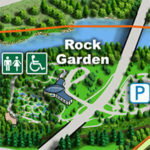| Membership | Price (+HST) |
|---|---|
| Single | $85/year |
| Single Plus | $120/year |
| Family | $130/year |
| Family Plus | $175/year |
| Contributing | $300/year |
| Supporting | $600/year |
| Sustaining | $1,000/year |
| Benefactor's Circle | $2,500/year |
| Director's Circle | $5,000/year |
| President's Circle | $10,000/year |
Host Plants for Butterflies and Moths
By Karin Davidson-Taylor, Education Program Officer, Royal Botanical Gardens
We see bees, butterflies and moths going from flower to flower feeding on nectar and transferring pollen, but what we don’t see as often are their caterpillars.
When deciding on the plants that support pollinator habitat in the garden, we need to consider their complete life cycle including the caterpillars. Butterfly and moth caterpillars eat the leaves of the plants that the eggs were laid on.
Some caterpillar species have very specific needs such as the Monarch which will only lay their eggs on milkweed plants, whereas others may eat leaves from a wide variety of plants such as Mourning Cloak caterpillars.
Here are five Ontario native plants you can add to your garden, with the conditions they need and the butterfly or moth species that will lay their eggs on it.
Big Bluestem
Andropogon gerardii

Big Bluestem is sometimes known as Turkeyfoot because the seedhead is usually branched into three parts resembling a turkey’s foot. If left undisturbed, it will spread, but if in grazing areas, this “ice cream for cows” has a hard time.
Light: part shade to full sun
Moisture: dry to medium
Soil: sandy loam
Mature Height: 2 metres (7 feet)
Mature Spread: under 1 metre (2 feet)
Caterpillar host: Common Wood Nymph
Cercyonis pegala


Black-eyed Susan
Rudbeckia hirta

This iconic summer perennial, sometimes known as Black-eyed or Brown-eyed Susan, is visited by a variety of pollinators in summer and birds in winter. If you want them to bloom longer, make sure they’ve got some afternoon shade.
Light: part shade to full sun
Moisture: dry to medium
Soil: sandy loam, loam, clay loam
Mature Height: under 1 metre (2 feet)
Mature Spread: under 1 metre (2 feet)
Bloom Time: July–August
Caterpillar host: Gorgone Checkerspot
Chlosyne gorgone


Joe Pye Weed
Eupatorium maculatum

What’s that you hear? Lots of pollinators visit Joe Pye Weed trying to get the nectar of the red-purple clusters of flowers. Luckily not too many types of wildlife like to munch on these very tall plants.
Light: part shade to full sun
Moisture: medium to wet
Soil: clay loam, organic
Mature Height: 2 metres (7 feet)
Mature Spread: 1 metre (3 feet)
Bloom Time: July–September
Caterpillar host: Ruby Tiger Moth
Phragmatobia fuliginosa


Lance-leaved Coreopsis
Coreopsis lanceolata

Lance-leaved Coreopsis is known as Lance-leaved Tickseed since the seeds look like ticks. This plant is tolerant of a lot of different soil and light conditions so will be an easy addition to most gardens. Don’t forget to take the old flower heads off to encourage more flowers to come. If you are looking for one of the caterpillars that uses this plant, good luck — it camouflages itself with bits of the flower’s petals as it feeds.
Light: full sun to shade
Moisture: dry to medium
Soil: sand loam
Mature Height: 0.5 metre (1.5 feet)
Mature Spread: under 1 metre (2 feet)
Bloom time: June–July
Caterpillar Host: Wavy-lined Emerald Moth also knows as Camouflaged Looper (Synchlora aerate)


Showy Tick-trefoil
Desmodium canadense

A valuable nitrogen fixer, Showy Tick-trefoil is also an important food source for a wide variety of wildlife including pollinators. This is an easy to grow plant that will thrive in a wide variety of soil, moisture, and light conditions. Seedpods are dispersed by clinging on to animal fur or clothing.
Light: sun
Moisture: Dry to moist
Soil: loamy soils
Mature Height: 1–2 metres (2–6 ft)
Mature Spread: under 1 metre (2 feet)
Bloom time: July–September
Caterpillar host plant: Silver-spotted Skipper (Epargyreus clarus)


You can do something to support this diversity of pollinators. Next time you are deciding what to add to your garden, consider at least one of these native species that support the complete life cycle of various butterflies and moths. The nectar for the adults and the leaves that the caterpillars depend on as a primary food source. If you plant them, they may come.
More from the RBG Blog
Check out RBG’s blog for announcements, articles, and more from Canada’s largest botanical garden.
Want to be sure you hear first? Sign up for our weekly e-newsletter to hear about upcoming events, weekend activities, articles, and more!












